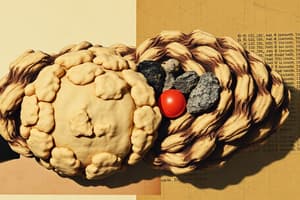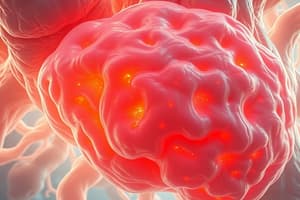Podcast
Questions and Answers
What is the primary location for the synthesis of ketone bodies in the body?
What is the primary location for the synthesis of ketone bodies in the body?
- Brain
- Kidneys
- Muscles
- Liver (correct)
During long periods of starvation, which fuel source can the brain start to utilize?
During long periods of starvation, which fuel source can the brain start to utilize?
- Ketone bodies (correct)
- Fatty acids
- Lactate
- Glucose exclusively
In what condition does uncontrolled diabetes most likely lead to ketosis?
In what condition does uncontrolled diabetes most likely lead to ketosis?
- Insufficient insulin leading to increased lipolysis (correct)
- High glucose levels without insulin deficiency
- Excess insulin production
- Decreased fatty acid oxidation
What is the role of glucagon during starvation in relation to ketogenesis?
What is the role of glucagon during starvation in relation to ketogenesis?
Which statement best describes the fate of ketone bodies in the body?
Which statement best describes the fate of ketone bodies in the body?
What biochemical pathway does enhanced gluconeogenesis interfere with during starvation?
What biochemical pathway does enhanced gluconeogenesis interfere with during starvation?
Which resource is primarily utilized by red blood cells (RBCs) for energy?
Which resource is primarily utilized by red blood cells (RBCs) for energy?
What is the significance of having a high glucagon to insulin ratio?
What is the significance of having a high glucagon to insulin ratio?
What is the consequence of increased lipolysis due to insulin deficiency?
What is the consequence of increased lipolysis due to insulin deficiency?
Hyperemesis during pregnancy can lead to which metabolic condition?
Hyperemesis during pregnancy can lead to which metabolic condition?
What is the primary function of white adipose tissue?
What is the primary function of white adipose tissue?
Which statement best describes the mitochondria presence in brown adipose tissue?
Which statement best describes the mitochondria presence in brown adipose tissue?
What key protein is involved in the thermogenesis process?
What key protein is involved in the thermogenesis process?
During fasting, what process allows for the release of fatty acids into the blood?
During fasting, what process allows for the release of fatty acids into the blood?
What is notably absent in the process of thermogenesis in the absence of uncoupling proteins?
What is notably absent in the process of thermogenesis in the absence of uncoupling proteins?
Which of the following statements about brown adipose tissue is NOT true?
Which of the following statements about brown adipose tissue is NOT true?
How does brown adipose tissue primarily generate heat?
How does brown adipose tissue primarily generate heat?
What is the primary storage form of energy in white adipose tissue?
What is the primary storage form of energy in white adipose tissue?
How many ATP are generated from 8 acetyl-CoA in the old ATP calculation system?
How many ATP are generated from 8 acetyl-CoA in the old ATP calculation system?
What is the main regulatory molecule that inhibits CAT1 during fatty acid synthesis?
What is the main regulatory molecule that inhibits CAT1 during fatty acid synthesis?
What is the net ATP yield from the complete oxidation of a fatty acid with 14 carbons using the new calculation system?
What is the net ATP yield from the complete oxidation of a fatty acid with 14 carbons using the new calculation system?
During which condition is beta oxidation promoted due to increased free fatty acids in tissues?
During which condition is beta oxidation promoted due to increased free fatty acids in tissues?
Which biological process is primarily inhibited when ATP levels are high?
Which biological process is primarily inhibited when ATP levels are high?
What is the initial product formed during the rate-limiting step of beta oxidation?
What is the initial product formed during the rate-limiting step of beta oxidation?
Which hormone is primarily responsible for promoting fatty acid synthesis during the fed state?
Which hormone is primarily responsible for promoting fatty acid synthesis during the fed state?
What is the effect of glucagon on fatty acid metabolism during starvation?
What is the effect of glucagon on fatty acid metabolism during starvation?
What is the overall total ATP gain from beta oxidation and the citric acid cycle for the complete oxidation of a fatty acid in the old system, assuming 18 carbons?
What is the overall total ATP gain from beta oxidation and the citric acid cycle for the complete oxidation of a fatty acid in the old system, assuming 18 carbons?
Flashcards are hidden until you start studying
Study Notes
Adipose Tissue Types
- White Adipose Tissue (WAT)
- Primarily functions in energy storage.
- Contains minimal mitochondria.
- Composed of 80% triglycerides (TAG), which require significant water for oxidation.
- Brown Adipose Tissue (BAT)
- Engaged in thermogenesis, uncoupling oxidation from phosphorylation.
- Abundant mitochondria and cytochromes contribute to its brown color.
- Critical for newborns and hibernating animals.
Thermogenesis
- Heat is generated by uncoupling oxidation from the phosphorylation process, releasing energy as heat rather than as ATP.
- Occurs via uncoupling protein (thermogenin).
Lipolysis
- Mobilization of stored fats during fasting results in fatty acids (FAs) appearing in the blood.
- Each turn of β-oxidation yields:
- Old system: 5 ATP (or 7 cycles resulting in 35 ATP).
- New system: 4 ATP (or 7 cycles leading to 28 ATP).
- Each Acetyl-CoA entering the citric acid cycle produces 12 ATP, leading to a total potential gain of 131 ATP in the old system.
- Example: Complete oxidation of an 18-carbon fatty acid using the new system results in significant ATP production.
Importance of β-Oxidation
- Serves as an energy source during fasting.
- Provides Acetyl-CoA for synthesizing crucial compounds like cholesterol.
Regulation of β-Oxidation
- Feeding Status:
- Fasting promotes lipolysis and increases free fatty acids (FFA) in tissues, stimulating β-oxidation.
- Carbohydrate intake leads to higher insulin levels, inhibiting lipolysis and reducing β-oxidation.
- Rate-limiting step involves forming fatty acyl carnitine (catalyzed by CAT1), inhibited by malonyl CoA during the fed state.
- In starving conditions, the decreased malonyl CoA leads to increased β-oxidation.
Energy Needs of Cells
- High ATP levels reduce respiratory chain activity, leading to elevated FADH2 and NADH levels, inhibiting dehydrogenases of β-oxidation.
- Conversely, low ATP levels stimulate β-oxidation as NADH and FAD are oxidized.
Ketogenesis and Ketolysis
- Ketone bodies formed in the liver are utilized in extrahepatic tissues, providing alternative fuel sources for heart muscles and during prolonged fasting.
- RBCs primarily utilize glucose, while the brain usually relies on glucose but can adapt to ketone bodies during starvation.
Ketosis
- Arises from uncontrolled diabetes (DM) or prolonged starvation, causing a lipolytic response and an increase in ketone bodies due to excess Acetyl-CoA.
- Enhanced gluconeogenesis limits acetyl CoA's entry into TCA, resulting in ketone body production.
Management of Ketoacidosis
- Initial treatment includes administering fluids and insulin to lower blood sugar levels and stabilize the patient.
Studying That Suits You
Use AI to generate personalized quizzes and flashcards to suit your learning preferences.




